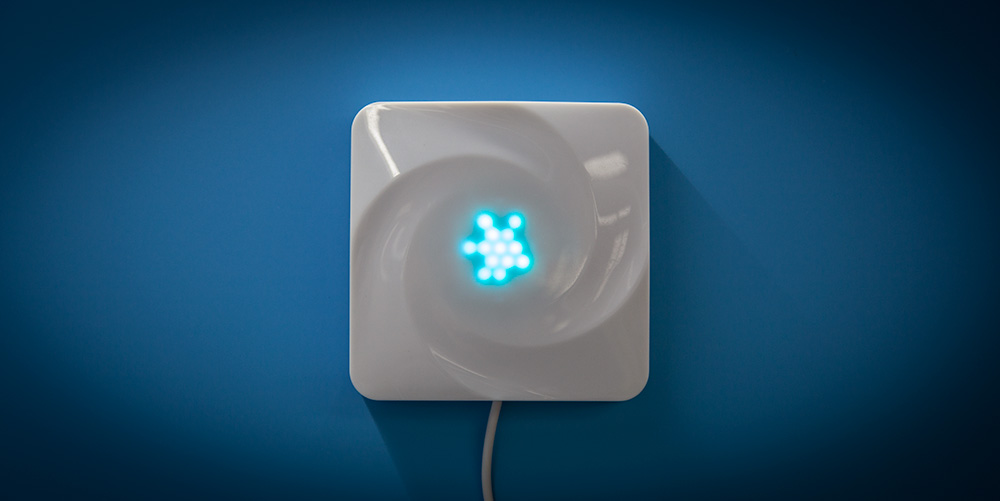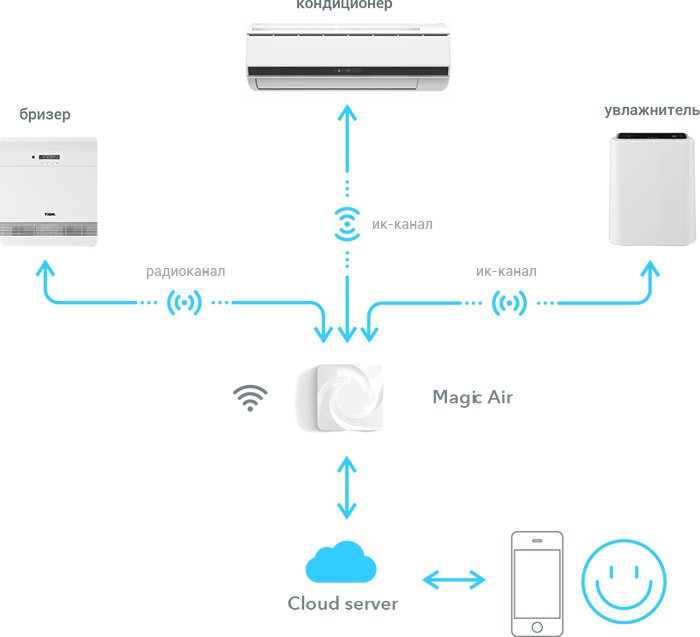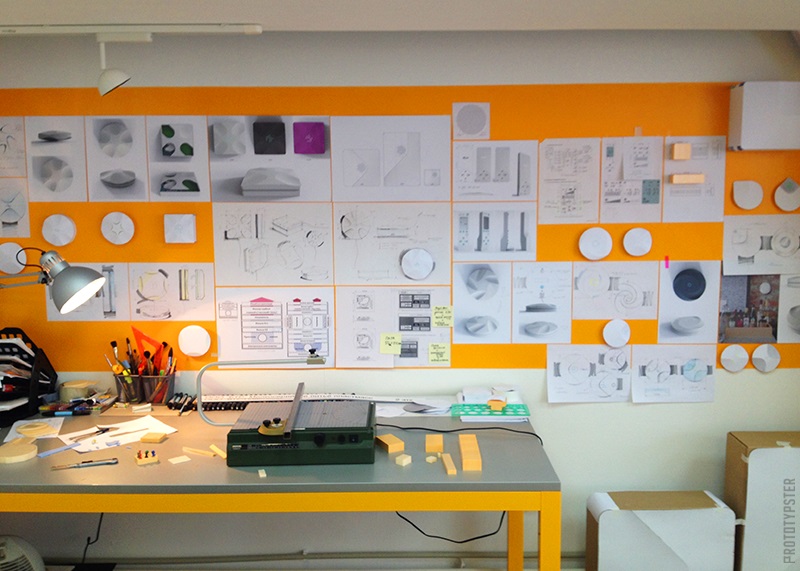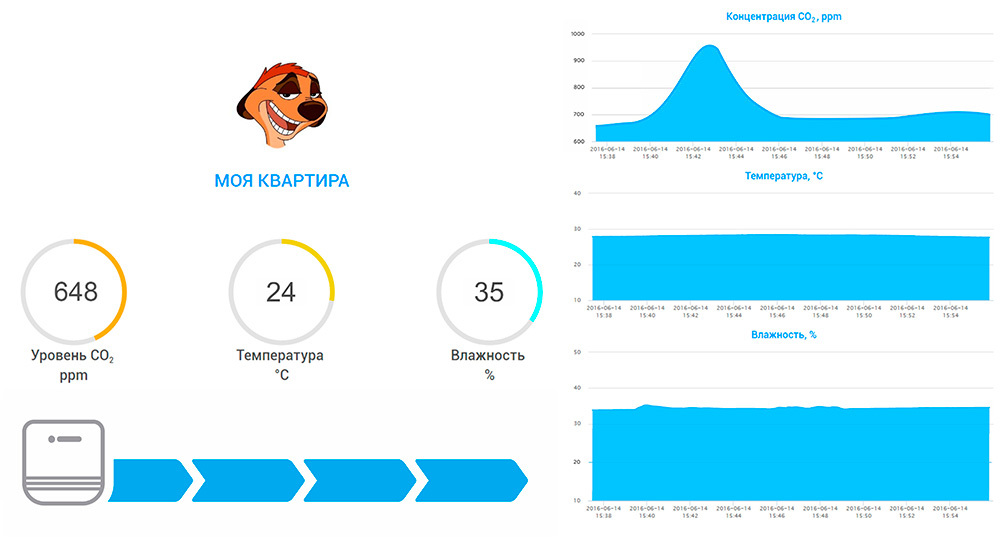Chief in climate in your house. TION MagicAir Announcement
Hi, Geektimes! On June 7, in Moscow, we officially presented an interesting device, our new development - the TION MagicAir smart microclimate system . If you thought that immediately after the announcement, all previous devices of our company instantly turned into a pumpkin and morally obsolete, then no - on the contrary, now you can give them a second wind and independence. The novelty will be able to lead the work of climate devices in your home. Interesting? Then welcome under cat.

In our blog, we have repeatedly written about breathers, air supply and purification systems - we are pleased that you are all technically savvy people and you do not need to chew on quite simple physical processes and the benefits of fresh air for the body. It's nice that many of you are interested in our devices and you sometimes send us your feedback, the most interesting and detailed of which we publish on our blog.
Until recently, breathers were devices that either worked all the time, or which had to be turned on manually (for example, when guests arrived) - we understood this inconvenience and therefore worked on it. The solution was a new climate control platform, which appeared to the public in the face of the TION MagicAir gadget - a compact box that saves the user from having to do anything manually (except for the initial setting) in the climate control issue.
')

TION MagicAir measures the parameters of air in an apartment or office, and also controls the nearby climate technology. We were able to pack a rather complicated engineering system (in fact, this is a whole component or even a segment of a “smart home”) in a small box that is controlled by an application on a smartphone.
Developing this device, we aimed to make not just a “traffic light” for indicating the air quality (of which there is already a car and a small trolley, for example ), but a full-fledged control device that could influence the indoor climate. As a result, on board the device there are:
- Sensitive CO 2 sensor
- humidity sensor
- Temperature sensor
- Radio module (to control other devices over the radio channel)
- Wi-Fi module (for communication with a smartphone)

Speaking more simply, now you will have the necessary arsenal that can not only “measure stuffiness” by key characteristics, but also automatically manage the operation of climate devices to maintain the desired level of air quality. And for this it is enough to do three simple steps:
 We install compact ventilation: Tion O2 MAC breather (other models can also be used, but for this you need to replace the “brains” - this can be done by our customer service). Installation of the breather takes about an hour, for ready repair, without dirt and complicated work. The device forcibly supplies fresh air from the street, cleans and warms up - it will be possible not to open the windows, and also to forget about noise, dust and drafts in the apartment.
We install compact ventilation: Tion O2 MAC breather (other models can also be used, but for this you need to replace the “brains” - this can be done by our customer service). Installation of the breather takes about an hour, for ready repair, without dirt and complicated work. The device forcibly supplies fresh air from the street, cleans and warms up - it will be possible not to open the windows, and also to forget about noise, dust and drafts in the apartment.
 Install the MagicAir base station in a convenient place and connect it to any USB port or 220V network. We set up radio communication with the breather and set up Internet access via Wi-Fi. Sensors inside the base station will measure air quality and send data to the cloud server. The history of data is saved and the user can see the dynamics of humidity, CO 2 , temperature in the context of the rooms for the period on the smartphone screen. And this is not just a statistic with a beautiful schedule - based on the dynamics of indicators, you can rebuild the air conditioning system in the apartment and optimize the costs of maintenance of equipment and electricity.
Install the MagicAir base station in a convenient place and connect it to any USB port or 220V network. We set up radio communication with the breather and set up Internet access via Wi-Fi. Sensors inside the base station will measure air quality and send data to the cloud server. The history of data is saved and the user can see the dynamics of humidity, CO 2 , temperature in the context of the rooms for the period on the smartphone screen. And this is not just a statistic with a beautiful schedule - based on the dynamics of indicators, you can rebuild the air conditioning system in the apartment and optimize the costs of maintenance of equipment and electricity.
 We indicate in the mobile application (currently the MagicAir application is available in the AppStore and GooglePlay ) the standard level of CO 2 in the room. If this level is exceeded (for example, when people appear in the room), the base station itself will choose the optimal breather mode, and when the CO 2 level goes down, the system will automatically reduce the ventilation power or turn off the breather altogether. This, by the way, is also energy efficient.
We indicate in the mobile application (currently the MagicAir application is available in the AppStore and GooglePlay ) the standard level of CO 2 in the room. If this level is exceeded (for example, when people appear in the room), the base station itself will choose the optimal breather mode, and when the CO 2 level goes down, the system will automatically reduce the ventilation power or turn off the breather altogether. This, by the way, is also energy efficient.

MagicAir has the ability to manage up to 32 devices - this is more than enough even for the largest country house and especially an apartment. At the moment, only the breather of our company is supported from the devices, but in the future the range of supported climate devices will increase - many models of air conditioners, humidifiers, air purifiers, etc. will be included there.

A little later, we plan to add our own actuators: valves for batteries, exhaust fans, sets of other air quality sensors, and so on. And all this wealth to maintain air quality will automatically be controlled by one small box. Which does not look like antediluvian hygrometers or a monitor-gas analyzer - last year, MagicAir managed to receive the RedDot Design Award 2015 award in the Domestic Aid category (household goods) and would most likely harmoniously fit into almost any interior.

At the presentation of the product there was a small demo stand, which was a glass cabin with a perimeter closed with a breather installed inside (connected with a corrugated pipe to the street), Magic Air and a screen with an air quality monitoring system. The breather was initially turned off, but configured to automatically turn on through MagicAir when it reaches a carbon dioxide content of 950 ppm.

The booth was so small that one person was enough to demonstrate the operation of the devices inside - the concentration of carbon dioxide began to grow like yeast. When the target level reached 950 ppm, the Magic Air team started a breather, which quickly began to pump fresh air from the street to the optimum value (which can also be set in the settings).

As a side experiment, during the presentation CO 2 concentrations were measured in the hall itself, where there were a total of about 40 people - in less than half an hour the concentration increased to “uncomfortable” 1500 ppm, the regular loft ventilation could not do anything about it.
Unlike existing technologies for building a smart home, MagicAir is designed for ordinary users so that anyone, not just hardcore techie, can install it on their own. But at the same time, we plan to release DevKit, with which you can create your own applications for managing climate technology. As they say, stay tuned.
Taking this opportunity, we cannot fail to mention that the device has been developed and made entirely in Russia (in Novosibirsk) - abroad we buy only a certain amount of “crumbling” and some small parts that are simply not present on our cold lands.

Denis Volkov (product developer) and Mikhail Amelkin (CEO)
Oh yes. The device is already on sale at a price of 8900 rubles apiece (for comparison, the “traffic light” Netatmo, mentioned above, costs almost twice as much). Separately and at a lower price, it will soon be possible to buy additional sensors that can be placed in different rooms and integrated into a common ecosystem.
A more detailed overview of the device itself and the application will do later.
Have questions? Ready to answer them in the comments.

In our blog, we have repeatedly written about breathers, air supply and purification systems - we are pleased that you are all technically savvy people and you do not need to chew on quite simple physical processes and the benefits of fresh air for the body. It's nice that many of you are interested in our devices and you sometimes send us your feedback, the most interesting and detailed of which we publish on our blog.
Until recently, breathers were devices that either worked all the time, or which had to be turned on manually (for example, when guests arrived) - we understood this inconvenience and therefore worked on it. The solution was a new climate control platform, which appeared to the public in the face of the TION MagicAir gadget - a compact box that saves the user from having to do anything manually (except for the initial setting) in the climate control issue.
')

TION MagicAir measures the parameters of air in an apartment or office, and also controls the nearby climate technology. We were able to pack a rather complicated engineering system (in fact, this is a whole component or even a segment of a “smart home”) in a small box that is controlled by an application on a smartphone.
Developing this device, we aimed to make not just a “traffic light” for indicating the air quality (of which there is already a car and a small trolley, for example ), but a full-fledged control device that could influence the indoor climate. As a result, on board the device there are:
- Sensitive CO 2 sensor
- humidity sensor
- Temperature sensor
- Radio module (to control other devices over the radio channel)
- Wi-Fi module (for communication with a smartphone)

Speaking more simply, now you will have the necessary arsenal that can not only “measure stuffiness” by key characteristics, but also automatically manage the operation of climate devices to maintain the desired level of air quality. And for this it is enough to do three simple steps:

MagicAir has the ability to manage up to 32 devices - this is more than enough even for the largest country house and especially an apartment. At the moment, only the breather of our company is supported from the devices, but in the future the range of supported climate devices will increase - many models of air conditioners, humidifiers, air purifiers, etc. will be included there.

A little later, we plan to add our own actuators: valves for batteries, exhaust fans, sets of other air quality sensors, and so on. And all this wealth to maintain air quality will automatically be controlled by one small box. Which does not look like antediluvian hygrometers or a monitor-gas analyzer - last year, MagicAir managed to receive the RedDot Design Award 2015 award in the Domestic Aid category (household goods) and would most likely harmoniously fit into almost any interior.

On the day of the presentation
At the presentation of the product there was a small demo stand, which was a glass cabin with a perimeter closed with a breather installed inside (connected with a corrugated pipe to the street), Magic Air and a screen with an air quality monitoring system. The breather was initially turned off, but configured to automatically turn on through MagicAir when it reaches a carbon dioxide content of 950 ppm.

The booth was so small that one person was enough to demonstrate the operation of the devices inside - the concentration of carbon dioxide began to grow like yeast. When the target level reached 950 ppm, the Magic Air team started a breather, which quickly began to pump fresh air from the street to the optimum value (which can also be set in the settings).

As a side experiment, during the presentation CO 2 concentrations were measured in the hall itself, where there were a total of about 40 people - in less than half an hour the concentration increased to “uncomfortable” 1500 ppm, the regular loft ventilation could not do anything about it.
Unlike existing technologies for building a smart home, MagicAir is designed for ordinary users so that anyone, not just hardcore techie, can install it on their own. But at the same time, we plan to release DevKit, with which you can create your own applications for managing climate technology. As they say, stay tuned.
Taking this opportunity, we cannot fail to mention that the device has been developed and made entirely in Russia (in Novosibirsk) - abroad we buy only a certain amount of “crumbling” and some small parts that are simply not present on our cold lands.

Denis Volkov (product developer) and Mikhail Amelkin (CEO)
Oh yes. The device is already on sale at a price of 8900 rubles apiece (for comparison, the “traffic light” Netatmo, mentioned above, costs almost twice as much). Separately and at a lower price, it will soon be possible to buy additional sensors that can be placed in different rooms and integrated into a common ecosystem.
A more detailed overview of the device itself and the application will do later.
Have questions? Ready to answer them in the comments.
Source: https://habr.com/ru/post/395151/
All Articles